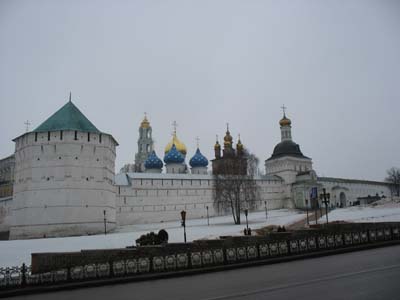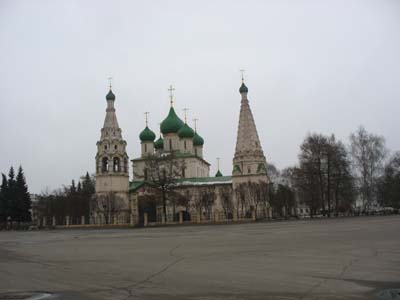-- The Golden Ring

The Golden Ring is a loop, in the
North-East of Moscow, old towns that preceded it as political and
cultural centre. They constitute an architectural album of churches,
monasteries, kremlins and museums. They were founded in the 12th century.
Vladimir became the capital of Russia in 1169. In 1237 they were sacked
by Mongolian Golden Horde. Then they were absorbed by the principality of
Moscow in the 14th century.
The majority
of monuments were rebuilt in the 16th and 17th century after the
Mongolian's sack. Some monuments, at Vladimir and Bolgolyubovo, preserved the artistic tradition of Kiev.
Sergiev-Posad was the first visited town. There is no prohibition for trucks. I chose a guarded carpark near to the Kremlin. The monuments are representative of the architecture of Kiev. “Trinity Cathedral” has the grave of St Sergius. In front of Cathedral-of-the Assumption two monuments draw the attention, “Chapel-at-the Well” for the splendour of its interior decoration and the grave of Boris Godunov, only Tsar not buried in Saint-Petersburg or Moscow.

Trinity Monastery of St Sergius
Sergiev-Posad
01/04/2006
Rostov-Veliky is located on the road to Yaroslavl. I left the truck on the train station carpark to go to visit the monastery to 1,5 km. The cathedral of the Assumption has a Belfry of 15 bells all named. The site is degraded enough. However the exhibitions are worthy of interest, they exhibit icons as well as liturgical objects giving an outline of the religious art.

Gate church of the
Resurrection
Rostov-Veliky
02/04/2006
Yaroslavl is a great industrial centre. The centre town is prohibited for truck. I found a guarded park before a bridge on the Kotorosl river. The city is pleasant to visit. In the mid-day streets were very animated, weather was sunny with a temperature of +8°C. The Internet café of Dom Kultury not authorizing the use of the "cmd.exe" function, the engineer who supervised did itself the update of my website with a Russian file transfer programme. The Monastery of the Transfiguration of the Saviour is closed on Monday except tourist season.

Church of Elijah the
Prophet
Yaroslavl
03/04/2006
Kostroma is located at the edge of the Volga. I stayed for two overnights at the edge of the frozen river at the bottom of the esplanade prolonging the “Ivan Susanin” garden where young people of the city came in groups for drinking and discussing until twilight. The centre town was very animated during my stay. The main monument is the St Ipaty monastery founded by Boris Godunov and embellished by Romanov.

St Ipaty
Cathedral
Kostroma
05/04/2006
Suzdal is a village
organized along the Lenin street, where many monasteries, churches,
museums testify to its glorious past. The museum of the monastery of
“Nativity of the Virgin Cathedral” exhibits collections of icons and
objects in all remarkable points.
I was led by police on a guarded carpark in the tourist
complex.

Intercession Cathedral
Suzdal
07/04/2006
On the road to Vladimir, I made a detour to visit the Church of “intercession-one-the Nerl” in Bogolyubovo which is regarded as jewels of the religious art in the 12th century. Two other monuments in Vladimir takes part in this heritage.

Church of the
Intercession-at-the Nerl
Bogolyubovo
08/04/2006

Assumption
Cathedral
Vladimir
08/04/2006
Cathedrals and churches of
the Golden Ring belong to the style called Byzantine of Kiev and are
generally built out of bricks. They adopt the architecture of the Greek
cross and are of modest size. The walls are covered with frescos. The
narthex is separated from the room of prayer by a wall out of gilded
carved wooden and covered with icons. The unit releases an impression of
meditation raised by incense.
By visiting them I assisted several times with the religious offices. The
faithful are upright in front of the narthex where the ceremony
is held of which a part is out the sight of the assistance, the doors of the
narthex close themselves during the ritual. The crowd of believing is made
up people of all ages.
The liturgy of the Russian orthodox catholic religion appears different
from the Roman catholic liturgy. The sacerdotal clothes are very worked.
The a capella choruses mainly composed by women answer the priests and are remarkable.
The following days were devoted to head off towards the Ural to leave Europe and to enter Asia.